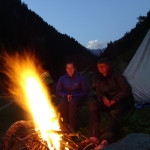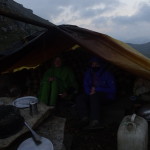All Treks are different. There are trekking routes with well-developed paths and trails, treks with tea houses along the way, where you can get accommodation and food. There are low-altitude tours and there is the Bara Banghal Trek. A trek, on which for several days there are a lot of goats and sheep, but no civilization. A trek on which one crosses glaciers, rocks and goats.. On which it goes up to 4700 meters and a trek on which the paths can occasionally be buried by landslides. A trek on which you have to be flexible depending on weather conditions and other situation.
A Trek, which starts in the Kullu Valley from Manali and leads over two passes into the Kangra Valley near Daramshala. The name comes from the remote village of Bara Banghal, which is located halfway through and can only be reached on foot in several days. The village is a real highlight during the trek and invites for a rest day, but more on that later.
But the trek could just as well be called Shepherd Trek, because the route is composed of old shepherd trails. Or according two one of the 4600 meters high passes Kalihani and Thamsar. Or also Himalaya Trek, as one crosses a good part of the highest mountain range in the world and has views of several 6000 meters peaks.
The Bara Banghal Trek is my personal favorite trek! I love to let my normal life behind me for several days and just have my little trekking team, mountains, rivers, trees and snow around me. On a 12 days trek one can really switch off and gets the focus back on the essentials, namely running, eating, sleeping and enjoying the wonderful mountain world.
The Bara Banghal Trek is physical demanding. Twice the route takes you over high mountain passes. The Kalihani Pass, which separates Manali from Bara Banghal, is 4700 meters high, the second pass between Bara Banghal and Bir, the end point of the trek in the Kangra Valley, is about 4600 meters high.
So there are many meters of altitude to be covered, even in between it often goes up and down and the daily distance of 4 to 8 hours is not excessively long, but in the long run nevertheless demanding.
The Bara Banghal Trek requires a local team. As already mentioned, the trek is not a route designed for trekkers, but a combination of old shepherd trails, which are sometimes more or less visible or sometimes not even present anymore.
Again and again a good point for the many rivers crossings have to be found, on top of the passes you can suddenly disappear into the fog with no real orientation anymore and the many glaciers offer their natural dangers.
Even a horseman with load horses and a cook along make sense, as carrying 12 days of food ration, tents and other equipment can be quite a load.And with a trekking cook along, you are provided with a culinary variety and a good insight into the Indian cuisine. Oh, it’s also fun to sit together in the kitchen tent in the afternoon, prepare dinner together and share stories. After twelve days, one has built up a close relationship with the Indian trekking team!
The high number of shepherds with there herds one meets on the route, are not only a nice change, but also a great option to exchange fresh milk, lassi and meat.
One of the highlights of the trek, as mentioned earlier, is the Bara Banghal Village.
It is kind of nice to have small destinations during the trek and this twelve-day trek offers besides two passes, lakes, small peaks, rivers, shepherds, also the village with villagers who live completely secluded in the middle of the Himalayas nd have still a very traditional lifestyle as farmers and shepherds. The small community on the river Ravi, located between the two passes and on 2500 m, is home to 300 souls.
There is no electricity, the houses are built completely of wood including the roof. The villagers grow kidney beans, potatoes, peas, some vegetables for their own needs and also little bit of cannabis. (In winterseason, people move across the Pass to Bir to sell one or the other product). They also have cows, sheep and goats. Fruit trees and small gardens are located between the houses and are lovingly maintained and there is even a school on the other side of the river.
The people are very friendly to us, give us peas and a pumpkin for our supper and show us open-minded their village. Children follow us and we feel like the flute player of Hameln ( a german story). we are handed blue berries that grow on trees and remind us of blueberries. Uur guide gets involved in a cricket game near the village tree and we watch the knitting women standing in a queue for a weekly phone call with the satellite phone.
We like it here and enjoy the rest day, after six days of marching from Manali we needed that break. Especially the last two days after crossing the pass were a bit more demanding and longer. In addition, we do yoga and painting, practice indian cooking and wash not only us, but also our clothes.
We are lucky with the weather. In September, shortly after the monsoon season, the sky is clear, the visibility excellent and the sun still warm.
We leave Bara Banghal to tackle the second half of the trek. It is important to cross the Thamsar Pass and in the base camp we realize that we are in the middle of the Himalayas and that the mountain weather here can change in minutes. Suddenly clouds rise, it gets dark and begins to pour. Good that we are safely in our tents.
The next morning the rain stops and we see that it has even snowed further up near the pass. So early in September, the shining sun still has strength and the snow melts quickly. Later in the year, such a change of weather can mean the end of the trek, or several days or weeks of stay in the village of Bara Banghal- at least for the horseman, as horses can no longer cross the passes in snow.
But we are lucky. It is sunny now and we cross pass number two.
Our last camp is set up in Billing – supposedly the second best place for paragliding in the World. In fact last year the World Cup in paragliding took place here. It is fun to watch the colourful paragliders fly down to Bir, but we decide to walk the last stage to Bir the next day.
The Bara Banghal Trek is really special and should be done either in early July before the monsoon season, or early September, shortly after monsoon. Otherwise, due to the snow, it is hardly possible to cross the high mountain passes.
Despite the beauty of the trek, with daily changing panoramas and landscapes (forests, flower meadows, sheep pastures, glaciers, moraines, rocks, fields, boulders, etc.), the Bara Banghal Trek is only done by a few trekkers a year. Rarely there are more than 5 trekking groups per season. For me, this rarity of the trek is another big plus point. We ourselves came across no other trekkers and met only locals and shepherds during the twelve days.
Our small group consisting of our guest Anja, our mountain guide Jogi, Ashok, the cook, the horseman Jogender with his five horses and myself, has grown together to a great team and saying good bye at the end of the trek was difficult for all of us! Doing the Bara Baghal Trek together means community, teamwork, flexibility, support, perseverance and trust. Thank you for this great time!
Here the link to the 12 days Bara Bangha Trekking tour with us.







































